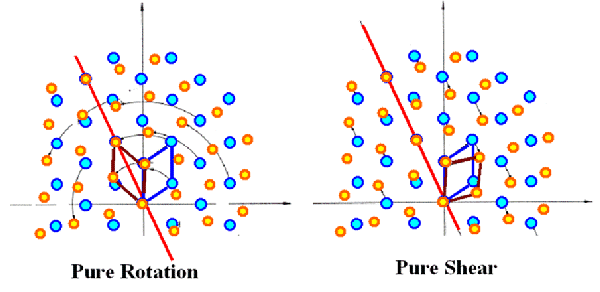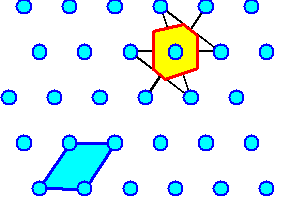 |
The math and physics of the O-lattice is not
particularly easy because there are some tricky details to keep in mind. In
this paragraph some of the problems, tricks and helpful definitions are just
summarized; in due time they may be specified in more details
|
 |
It is useful in many cases to decompose the
transformation matrix A into matrices that
describe the volume deformation (elongating or shortening only the axes of the
crystal), the shear deformation (only changing the angles between the axes) and
the rotation of the coordinate system of crystal I separately. |
|
 |
This may allow a better grasp of the real situation and helps,
if necessary, to use approximations only for suitable parts of the system. |
|
 |
The main reason, however, lies in the fact that the pure
rotation is not unambiguously defined. Depending on the basic symmetries of the
system, the same final state of orientation can be obtained by many different
rotations - but only one (ore one set) may make sense physically. This leads to
the next point: |
 |
The choice between various possible
transformations A. There are many possible
ambiguities, not only with respect to the rotation part, but also, e.g., in the
relations between pure shear and pure rotation; an example is shown below |
|
 |
Starting from an identical lattice I, identical lattices II
can be produced either by pure shear or by pure rotation. |
|
|
|
|
|
 |
|
|
|
|
 |
Mathematically, there is no difference but physically the two
transformations are not the same. Which one is the physically sound one? As it
turns out, the criterion is to preserve nearest neighbor relationships.
Mathematically, this means (and this is not easy to show), that from all
transformation matrices the ones that has to be chosen is the one with the
smallest numerical value of its determinant. this requires, of course, that
you know all the possibilities for Ain the
first place. |
 |
If one looks at the solutions of the basic
equation
(I - A)r0=T(I)
one realizes that the type of solution depends on the
rank of the matrix A. |
|
 |
For
rank (A)=3
the solutions - define points in O-space, i.e. an O-lattice. For
, the solution are lines, and for
rank (A)=1 planes.
For rank (A)=0, we have the trivial
case of identity. |
 |
Solving the basic equation produces the O-lattice
and at the same time one unit cell of the O-lattice. However, the
"natural" unit cell" obtained by simply connecting O-lattice
points may not be the physically most sensible one. |
|
 |
Why not take the Wigner-Seitz cell? What this
means is illustrated below: |
|
|
 |
|
 |
Again, the right choice must come from the physical meaning of
the O-lattice. This we will discuss in the next paragraph. |

